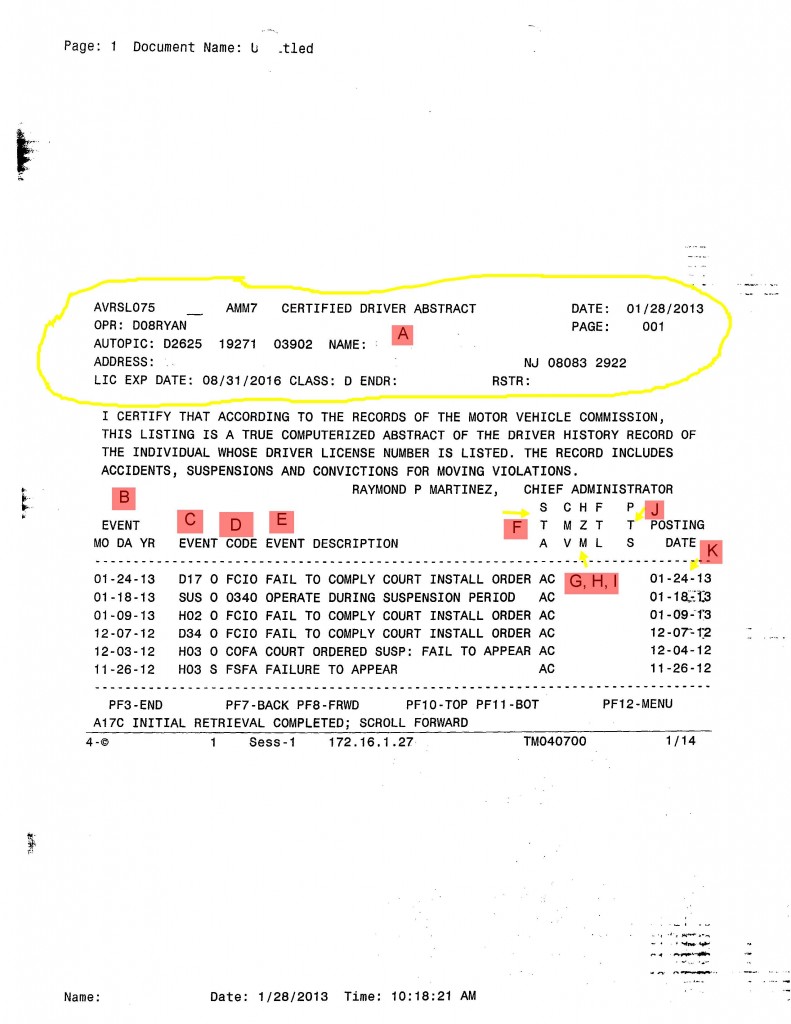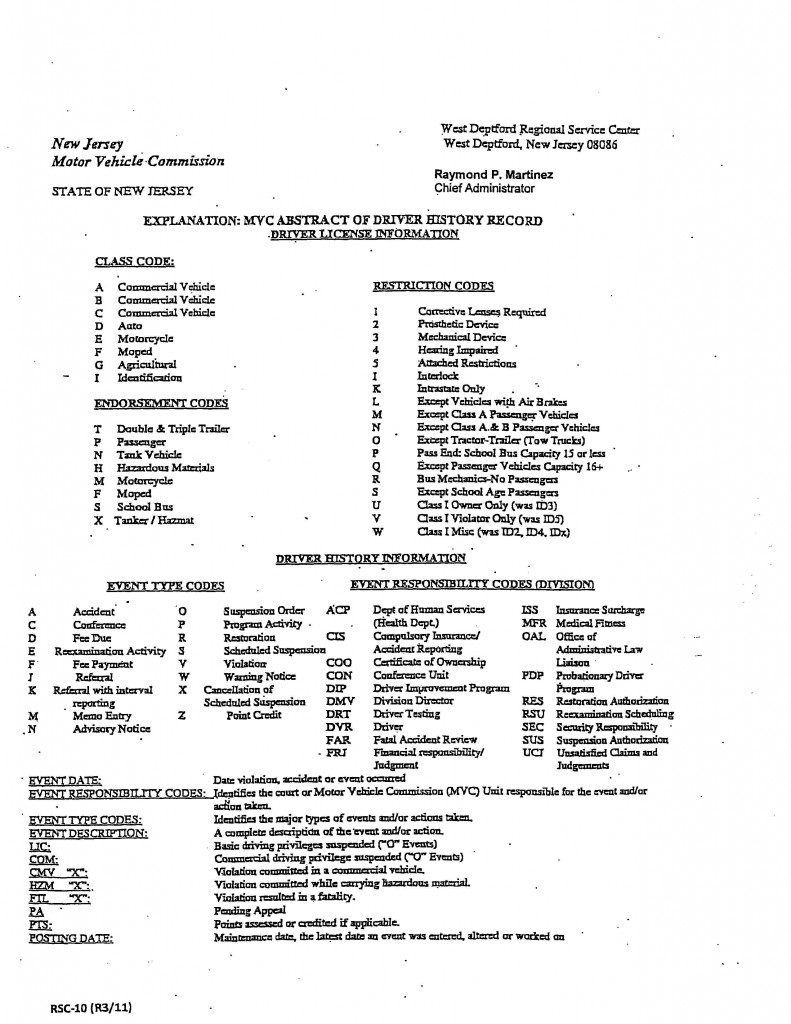How to Read a Motor Vehicle Abstract or Driving Record
Have you ever gotten a copy of your New Jersey Motor Vehicle abstract, or your client’s abstract, and you have been embarrassed because you were not able to read it? Well don’t be. I have quickly learned that most clients and many attorneys, including those that handle municipal court work regularly, simply don’t know how to read this crucial document. So, without further ado, I will try to clarify for you below.
Weather you are in a motor vehicle accident or needing to appear in court for a ticketed offense. You and your lawyer should be able to decipher the information on this important document.
A typical New Jersey Motor Vehicle Abstract will start with a host of information at the top, to identify the driver, such as name, address, date of birth and type of driver’s license (basic, commercial, motorcycle etc.) among other information. See “A”.
Below the identifying information is the Motor Vehicle Abstract, starting from most recent event and working backwards. The information is organized by row, where each new event is listed in a new row.

Column Codes
Starting from the left hand side, the most recent event is listed. It identifies the following:
1) “Date that the event occurred” (See “B”)
2) “Type of event” – which is a 3 digit code and then a singular letter next to it (See “C”);
3) “Code” – which is a 4 digit code described below (See “D”);
4) “Event Description” – which briefly describes what occurred (See “E”)
5) “STA”, (See “F”) – this is an internal code used by the NJMVC
6) “CMV”, (See “G”) – if there is an x in this column, it means that the violation was committed in a commercial vehicle;
7) “HZM”, (See “H”) – if there is an x in this column, it means that a violation was committed in a vehicle containing hazardous
materials;
8) “FTL”, (See “I”) – if there is an x in this column, it means that the violation resulted in a fatality;
9) “PA”, – if there is a column with a PA and there is an X in it, it means the violation is being appealed;
10) “Points, or PTS” (See “J”) – designates whether you added or subtracted points on your license due to this event;
11) “Posting Date” (See “K”) – This is the date that the NJMVC recorded and posted record of the event.
Here is a simplified explanation of each column, what it means and how to read them.
1) “Date that the event occurred” (See “B”) – Self explanatory
2) “Type of event” – which is a 3 digit code and then a singular letter next to it (See “C”);
A) If it is a letter, followed by 2 numbers, that is a code for a specific township court; you need to look at the municipal code
directory, which will tell you which township this event occurred in. See https://www.judiciary.state.nj.us/directory/munctadr.pdf to
identify the township this occurred in.
B) If the code is something like “SUS” or “RES” or “SEC” or “DMV”, that is an event that does not occur in any town, but is likely
instituted by the NJMVC. The common ones are:
a) SUS – means MVC has taken a suspension action
b) RES – means the MVC has taken a restoration action
c) DMV – means that the MVC is taking action
d) ISS – means insurance surcharge
e) CIS – compulsory insurance – usually this comes into play with an accident
Please see the below picture for a full list of event codes

Single letter Codes
Provides further information regarding what kind of action was taken. For a list of each letter and what they
mean, look up the letter in the attached help sheet: https://www.nj.gov/mvc/pdf/Licenses/understanding-abstract.pdf. Common ones are:
a) “O” – Suspension Order
b) “V” – Violation
c) “S” – Scheduled suspension
d) “F” – Fee Payment
e) “N” – Advisory Notice
f) “A” – Accident
3) “Code” – which is a 4 digit code described below (See “D”)
A) If the code starts with a number, it is the number of a traffic violation of the New Jersey Statute Annotated, Section 39
(traffic). For example:
0340 = N.J.S.A. 39:3-40 or Driving While Suspended
0329 = N.J.S.A. 39:3-29 or No License, registration or insurance ID in possession
4982 = N.J.S.A. 39:4-98.2 or speeding
B) If the code starts with a letter, it is simply a short version of the event description. A little bit of common sense can be used to figure
out the bulk of these. For example:
PC03 = Point credit, annual safe driving = 3 points off of the license for annual safe driving(3 points) (and the event
description usually says “Point Credit – Annual Safe Driving”)
FCIO = Failure to Comply with Court Install Order (FCIO is simply an abbreviation of the event description – Failure to
Comply with Court Install Order
RSTR = Restoration
POLC = Police involvement (typically an accident)
COFA = Court Ordered Suspension, Failure to appear
4) “Event Description” – which briefly describes what occurred (See “E”) – again, self explanatory, but here are some examples of common ones:
Failure to Comply Court Install Order – Typically means that the driver failed to make a payment with a time payment plan for that
particular court
Court Ordered Susp: Fail to Appear – Typically means the court in that town put a warrant out for that driver for failing to appear to a
scheduled court appearance
Failure to Appear – Driver failed to appear to court, but a warrant was not issued.
Operate During Suspension Period – violation of N.J.S.A. 39:3-40
Hearing Request Acknowledgment – Request for a hearing
No Lic, Reg or Ins ID in Possession – violation of N.J.S.A. 39:3-29
Unlicensed driver – violation of N.J.S.A. 39:3-10
Failure to wear seat belt – equipment violation
Maintenance of Lamps – equipment violation
Point credit – annual safe driving – In New Jersey, you can get 3 points reduced from your driver’s license if you drive an entire year
without incurring additional violations or suspensions. Here is a link to a list of other ways you can remove points from your New Jersey
license, including taking a defensive driving course or improvement program: https://www.nj.gov/mvc/Violations/penalties.htm
5) “STA”, (See “F”) – This is an internal NJMVC code that has no impact on your understanding of your abstract
6) – 11) – See Above
At the end of the abstract, you will be able to tell if the driver’s license is currently in good standing or suspended. It will say “Good Standing” Or “Suspended ___________” and the blank will indicate what driving privilege is suspended.
Examples
Let’s do one example together. Take a look at the very first entry on the sample abstract I have provided (which has all identifying information redacted):
 1) Event date – This event occurred on 1/24/13. It is the most recent event
1) Event date – This event occurred on 1/24/13. It is the most recent event
2) Event code – D17 – This event occurred in a specific town. Looking up “D17” in the directory,
https://www.judiciary.state.nj.us/directory/munctadr.pdf, I see that D17 is Gloucester Township.
-Also, the singular letter is an “o”, which indicates that Gloucester Township put out a suspension order / suspended this
driver’s license
3) Code – FCIO – If you look ahead to the event description, it says “Failure to Comply Court Install Order”. So, FCIO is simply an
abbreviation of the event description
4) Event Description – “Failure to Comply Court Install Order” basically means what it says. This court, Gloucester Township, had this
driver on some requirement, most likely a payment plan, and the driver failed to make a payment.
5) There are no points for this event, and the suspension posted on the same day, 1/24/13.
So, to sum up, this entry indicates that the driver had to make an obligation or payment to Gloucester Township and failed this obligation or payment, and Gloucester Township ordered that the driver’s license be suspended effective 1/24/13.
Hopefully, this will clear up some questions you have about reading New Jersey Motor Vehicle Abstracts. If you have any entries that confuse you, or if you have any additional questions about reading motor vehicle abstracts generally, or anything else related to this post, please feel free to contact me at david@hasnerandhasner.com or by contacting my office at 856-282-0777. You can also contact the New Jersey Motor Vehicle Commission, Abstract Department for questions at 609-292-6100.
-David Hasner, Esq. – Hasner and Hasner, PA
*Disclaimer* Content posted in this blog is made for informational purposes only. Viewing this blog does not create and attorney/client relationship with Hasner and Hasner, PA. and/or David Hasner, Esq. If you have any questions about the information in this blog, contact David Hasner, Esq. or an attorney with knowledge in this area of law for a consultation.


